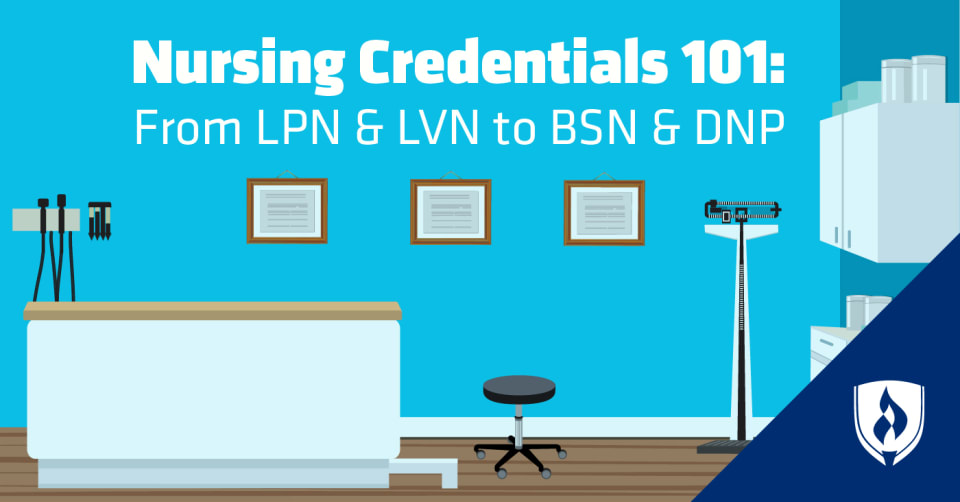
The nursing field can be tough and not for the faint of heart, but the idea of supporting your family while helping others really appeals to you. From what you can tell, the nursing vocation seems like an excellent option.
But as you’re starting to dig into potential nursing roles and what it takes to get there, you’re starting to get a little overwhelmed by the huge variety of nursing credentials and acronyms. In your research you’ve probably seen everything from CNA to LPN and RN to DNP—and that’s just a few! With so many nursing options to choose from, it can be a little confusing to figure out where to start and what the right option is for you.
Before choosing the program that best fits with your career aspirations, you’ll want to have a better handle on this alphabet soup of nursing abbreviations. We created this guide to help you wade through the sea of abbreviations as you start down the path of identifying which one might appear after your name one day.
Get Your Nursing School Questions Answered at a Nursing Information Session
Nursing credential: CNA
- What does CNA stand for? CNA stands for Certified Nursing Assistant.
- Education or training need: High school diploma plus nursing assistant training.
As the name suggests, CNAs assist nurses with patient admittance and vitals. It is the lowest-level credential related to the nursing field and the quickest point of entry. That said, it’s important to remember that CNAs are not technically nurses.
CNAs are required to pass a specialized exam that is tied to a single course in order to work in the field. A CNA provides basic care duties under the direction of the nursing staff, including feeding, dressing, bathing and transporting patients.
TIP: Becoming a nursing assistant is a great option for individuals who are considering a career in nursing, but aren’t quite convinced it’s the right path for them. Nursing assistant training can typically be completed in a matter of weeks, meaning you can get a taste of the healthcare field with minimal time investment.
Nursing Credential: LPN
- What does LPN stand for? LPN stands for Licensed Practical Nurse.
- Education or training need: Post-secondary certificate or diploma program.
Becoming an LPN requires a diploma in practical nursing and can be completed in as few as 12 months.2 After completing a program from an accredited school, LPNs sit for the National Council Licensure Exam (NCLEX-PN) to become certified.
Many LPNs work in clinics or private home settings and are responsible for registering patient vital signs such as heart rate and blood pressure, collecting blood samples and administering medications.
TIP: LPN tracks are often the first choice for those who want to begin a career as a nurse but do not have time to commit to a longer program right away. LPNs looking to advance from this point can continue their education and earn an RN credential through an LPN-to-RN bridge program.
Nursing credential: LVN
- What does LVN stand for? LVN stands for Licensed Vocational Nurse.
- Education or training needed: Post-secondary certificate or diploma.
LVNs have identical positions to LPNs. The only difference is that the term “vocational nurse” is the title used in California and Texas. Like LPNs, they complete a diploma program and must pass the NCLEX-PN for certification.
Nursing credential: RN (ADN and BSN)
- What does it stand for? RN stands for Registered Nurse. ADN stands for Associate’s Degree in Nursing. BSN stands for Bachelor of Science in Nursing.
- Education or training needed: Undergraduate degree (Associate’s or Bachelor’s).
Registered nursing is where things can start to get confusing. Basically there’s two degree paths to the job title of registered nurse. You can become a registered nurse by earning either an Associate’s Degree in Nursing (ADN) or Bachelor of Science in Nursing (BSN). No matter the path taken, registered nurses have a broader scope of responsibilities than LPNs. RNs with ADNs often assess patient needs, monitor patient symptoms, recommend care plans and educate patients on disease prevention and maintenance.
In most roles, registered nurses with a BSN credential largely perform similar duties to their ADN counterparts. However, nurses with the BSN credential may be eligible for more employment opportunities, and some employers may require their ADN nurses to eventually obtain a BSN. The BSN can also be valuable for nurses hoping to advance to leadership positions and pursue certain specialized roles.
RNs are certified through the NCLEX-RN examination which contains higher level nursing topics than the LPN version, the NCLEX-PN.
TIP: Want to learn more about the differences between ADN and BSN nurses? Our article “ADN vs. BSN: Your Guide to Help You Decide on a Nursing Degree” can help.
Nursing credential: APRN
- What does APRN stand for? APRN stands for Advanced Practice Registered Nurse.
- Education or training needed: Master’s degree or more.
Advanced practice registered nurses are a type of nurse who have obtained an advanced graduate-level nursing degree. One common graduate-level degree in nursing is the Master of Science in Nursing (MSN), but there are several variations including Master of Nursing (MN) and Master of Science (MS) or Master of Arts (MA) with a major in nursing. The APRN category covers quite a few nursing roles, including nurse practitioner (NP), clinical nurse specialists (CNS), nurse anesthetists and nurse midwives.
Nursing credential: DNP
- What does DNP stand for? DNP stands for Doctorate of Nursing Practice.
- Education or training needed: Doctorate degree.
There are several options for doctorate level degrees for nurses, including the Doctor of Nursing Practice (DNP) and Doctor of Nursing Science (DNS) or Doctor of Philosophy in Nursing (PhD). The DNP is more focused on patient outcomes and the nursing practice, while the DNS and PhD are paths that are typically more focused on research.
Find the right nursing credential for you
While this is only a fraction of the acronyms, abbreviations and jargon you’re going to encounter in the nursing field, you should now have a better understanding of some of the most common credentials you’ll see in this field. Take the next step by learning more about your options in our article, “Navigating Nursing Career Paths: 10 Popular Specialties to Pursue.”
Related Articles:
- ADN vs ASN: Is There Any Difference Between These Nursing Degrees?
- What Can You Do with an Associate's Degree in Nursing?
- ER vs. ICU Nursing: Which Healthcare Environment Suits You?
1Bureau of Labor Statistics, U.S. Department of Labor, Occupational Outlook Handbook, [accessed September, 2019] www.bls.gov/ooh/. Information represents national, averaged data for the occupations listed and includes workers at all levels of education and experience. Employment conditions in your area may vary.
2Completion time is dependent on transfer credits accepted and the number of courses completed each term.
EDITOR’S NOTE: This article was originally published in 2013. It has since been updated to include information relevant to 2019.




